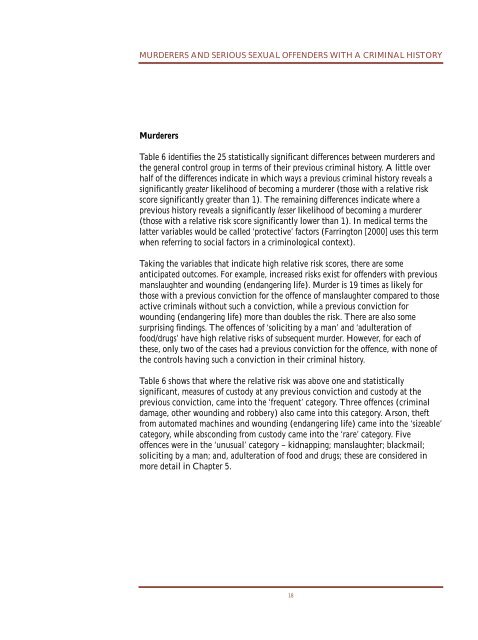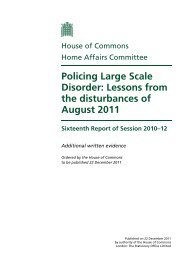Murder and Serious Sexual Assault - Lancaster EPrints - Lancaster ...
Murder and Serious Sexual Assault - Lancaster EPrints - Lancaster ...
Murder and Serious Sexual Assault - Lancaster EPrints - Lancaster ...
Create successful ePaper yourself
Turn your PDF publications into a flip-book with our unique Google optimized e-Paper software.
MURDERERS AND SERIOUS SEXUAL OFFENDERS WITH A CRIMINAL HISTORY<br />
<strong>Murder</strong>ers<br />
Table 6 identifies the 25 statistically significant differences between murderers <strong>and</strong><br />
the general control group in terms of their previous criminal history. A little over<br />
half of the differences indicate in which ways a previous criminal history reveals a<br />
significantly greater likelihood of becoming a murderer (those with a relative risk<br />
score significantly greater than 1). The remaining differences indicate where a<br />
previous history reveals a significantly lesser likelihood of becoming a murderer<br />
(those with a relative risk score significantly lower than 1). In medical terms the<br />
latter variables would be called ‘protective’ factors (Farrington [2000] uses this term<br />
when referring to social factors in a criminological context).<br />
Taking the variables that indicate high relative risk scores, there are some<br />
anticipated outcomes. For example, increased risks exist for offenders with previous<br />
manslaughter <strong>and</strong> wounding (endangering life). <strong>Murder</strong> is 19 times as likely for<br />
those with a previous conviction for the offence of manslaughter compared to those<br />
active criminals without such a conviction, while a previous conviction for<br />
wounding (endangering life) more than doubles the risk. There are also some<br />
surprising findings. The offences of ‘soliciting by a man’ <strong>and</strong> ‘adulteration of<br />
food/drugs’ have high relative risks of subsequent murder. However, for each of<br />
these, only two of the cases had a previous conviction for the offence, with none of<br />
the controls having such a conviction in their criminal history.<br />
Table 6 shows that where the relative risk was above one <strong>and</strong> statistically<br />
significant, measures of custody at any previous conviction <strong>and</strong> custody at the<br />
previous conviction, came into the ‘frequent’ category. Three offences (criminal<br />
damage, other wounding <strong>and</strong> robbery) also came into this category. Arson, theft<br />
from automated machines <strong>and</strong> wounding (endangering life) came into the ‘sizeable’<br />
category, while absconding from custody came into the ‘rare’ category. Five<br />
offences were in the ‘unusual’ category – kidnapping; manslaughter; blackmail;<br />
soliciting by a man; <strong>and</strong>, adulteration of food <strong>and</strong> drugs; these are considered in<br />
more detail in Chapter 5.<br />
18
















